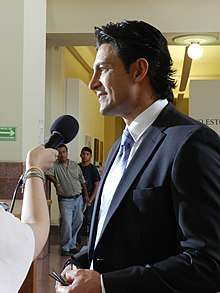Television in Mexico
Television is a popular form of entertainment in Mexico, with mass entertainment playing an important role in creating a national, unified culture.[2] The telenovelas are very traditional in Mexico and are translated to many languages and seen all over the world with renowned names like Lucero, Angelique Boyer, Adela Noriega, Maite Perroni, Diana Bracho, Leticia Calderón and Victoria Ruffo.

Network television
.jpg)

There are three major television companies in Mexico that own the primary networks and broadcast covering all nation, Televisa, TV Azteca and Imagen Television. Televisa is also the largest producer of Spanish-language content in the world and also the world's largest Spanish-language media network.[3] Media company Grupo Imagen is another national coverage television broadcaster in Mexico, that also owns the newspaper Excélsior. Grupo Multimedios is another media conglomerate with Spanish-language broadcasting in Mexico, Spain, and the United States.
Televisa, owns the Las Estrellas and Canal 5 networks, while TV Azteca owns the Azteca 7 and Azteca Uno networks.
There are also several other commercial networks with less than 75% national reach. Chief among these are Televisa's NU9VE, which in some areas shares time with regional programming, and Multimedios Televisión, which broadcasts mostly in northeastern Mexico.
Noncommercially, Canal Once operated by the Instituto Politécnico Nacional is the oldest educational television service in Latin America. The Sistema Público de Radiodifusión del Estado Mexicano (SPR) operates a network of digital retransmitters which offer multiple public television stations, including Canal 22, teveunam, Ingenio TV and its own Una Voz con Todos. As SPR's national transmitter network complements that of Canal Once, almost all of its stations also retransmit that network.
Television genres
Telenovelas

Mexico is one of the first countries in the world to be known for producing telenovelas aimed at shaping national social behavior – one issue of which is on family planning during the 1970s. The Mexican model of telenovelas (soap opera) – then to be replicated by other telenovela-producing countries in Latin America and Asia for most of the 1990s – usually involves a romantic couple that encounters many problems throughout the show's run, a villain and usually ends with a wedding. One common ending archetype, consists of a wedding, and with the villain dying, going to jail, becoming permanently injured or disabled, or losing his/her mind. The use of sexually themed episodes starring the leading couple of the story has been a common element through most Mexican (and even Latin American) telenovelas. Senda prohibida is the first telenovela produced in Mexico.[4][5] It was produced by Telesistema Mexicano and broadcast June 12, 1958, from Monday to Friday.[5]
Televisa and TV Azteca are the largest producers and exporters of Mexican telenovelas. Their main competitor is independent company Argos Comunicación. Telenovelas produced by U.S.-based network Telemundo tend to follow the Mexican model. Previously, telenovelas were often thought to be used as a government tool to distract citizens from national issues, a reason cited for temporary decrease in their credibility and popular appeal. Nowadays, Mexican television has managed to counteract government influence in its telenovelas. In particular, around 1990, Televisa found an enormous market for its telenovelas in regions such as Brazil and parts of Latin America, post-Cold War Eastern Europe and Asia. This precipitated the so-called 'Telenovela Craze'. Credited by media experts especially to Televisa's move in the early 1990s of exporting its telenovelas to parts of the world, this rivaled the wave of American sitcoms that had been broadcast worldwide in the same period.

During the peak of the global success of Latin American telenovelas in the 1990s and 2000s, several prominent Mexican actors and actresses gained huge following for the telenovelas that they starred and which were viewed in the mentioned regions. For example, Verónica Castro's international fame grew when the novela she had starred in many years earlier, Los Ricos Tambien Lloran in 1979, became a major hit in Russia. In the 1982 telenovela Vanessa, Lucía Méndez became the first star of a soap-opera to be killed; however, this was due to her alleged diva attitude which forced retaliation from the writers and producers to "kill Vanessa off", later she stated that she was sick with pneumonia and that's the reason why she couldn't shoot the last scenes. In the same period, Thalía earned the title as the 90's "Queen of Soap Operas" after starring in the so-called Las Tres Marias or the "Maria Trilogy" telenovelas – Maria Mercedes, Marimar and Maria la del Barrio – and Rosalinda, converting her into one of the world's foremost television icons, as her telenovelas were broadcast in Mexico and more than 180 other countries to almost 2 billion viewers worldwide, earning the all-time highest television ratings both in Mexico and other regions.
Due to the international success of the telenovelas broadcast in and out of Mexico, by the late 1990s, the company claimed that telenovelas were Mexico's leading export product. Many consider the period from 1958 to 2004 to be Televisa's Golden Age of telenovelas, at the same time when the Mexican government loosened its control over television. Telenovelas, primarily those produced by Argos Comunicación, consequently addressed new themes, including poverty, political corruption, immigration and drug smuggling. However, with American drama and comedy series becoming increasingly popular among Mexican audiences through cable or satellite television and unlicensed copying, the television companies opted to adapt stories from Argentina, Colombia and Brazil. These used veteran actors in order to decrease expenses.
Currently, the most successful telenovelas are being created by Argos and Telemundo and are rebroadcast (or adapted) by the main companies. The most successful one, La Reina del Sur, based on the book by Arturo Perez Reverte, is based on the true story of a female drug trafficker in Sinaloa. Though it was censored somewhat due to the Drug War and was broadcast on a low-rated channel, it achieved higher viewership than other programs in the same timeframe.
On November 21, 2016 Televisa released a telenovela titled La candidata (The Candidate) protagonized by actress Silvia Navarro as Regina Bárcenas (whom acts as the speculated fictional stand-in for Margarita Zavala) and Rafael Sánchez Navarro as her husband Alonso San Roman (which acts as the speculated fictional stand-in for Felipe Calderon). It is heavily speculated this television program, was created in order to favor Zavala in the 2018 elections against MORENA's political candidate Andrés Manuel López Obrador whom Televisa did not want as president due to his leftist political points of view.[6][7]
History

Television in Mexico first began on August 19, 1946 in Mexico City when Guillermo González Camarena transmitted the first television signal in Latin America from the bathroom of his home. On September 7, 1946 at 8:30 PM (CST) Mexico’s and Latin America’s first experimental television station was established and was given the XE1GC callsign. This experimental station broadcast an artistic program and interviews on Saturdays for two years.[8]
Mexico’s first commercial station, XHTV channel 4 in Mexico City, signed on August 31, 1950, making Mexico the first Spanish-speaking country to introduce television. It started transmitting regular programs on the following day. The first program to be broadcast was President Miguel Alemán Valdés IV Informe de Gobierno.[9] Within a year, XEW-TV channel 2, owned by the Azcárraga family, was formed. Mexico's first color television transmission was carried out by the third television station in the capital, González Camarena's XHGC Canal 5. In 1955, all three stations formed an alliance, Telesistema Mexicano (TSM), the predecessor to Televisa. In 1959, XEIPN-TV channel 11 signed on, the base of today's Canal Once network and the first educational television station in Latin America.
Broadcast expansion
With the exception of the short-lived but popular Televisión Independiente de México (1968–72), which TSM absorbed in 1973 to form Televisa, the latter saw no major commercial competition until 1993. Instead, the 1970s, 1980s and early 1990s were marked by a large expansion in state-owned television. This took flight in 1972 when the government, through financier SOMEX, expropriated XHDF-TV in Mexico City and used it to form the base of a Canal 13 national network with repeaters across the country. At the same time, a project known as Televisión Rural de México (later Televisión de la República Mexicana) sought to bring culture and information to rural Mexican audiences. In the 1980s, XHTRM-TV channel 22, the first UHF television station in the Valle de México, came to air bringing TRM programming to the nation's capital. In 1985, TRM was dismantled, and with the sign-on of XHIMT-TV channel 7 in Mexico City, the TRM repeaters were linked to that station, which became the flagship of the Red Nacional 7 of Imevisión. In 1993, Imevisión's privatization gave birth to Televisión Azteca.
This time period also saw the development of the first television networks run by state governments, including TVMÁS in Veracruz and TeleMichoacán. 25 of Mexico's 32 federal entities currently boast state networks.
Cable television

The first cable system started to operate in the early 1960s in Monterrey, as a CATV service (an antenna at the top of the Loma Larga, which could get TV signals from Laredo, Texas and the Rio Grande Valley). Most of the other major cities didn't develop cable systems until the late 1980s, due to government censorship. By 1989, the industry had had a major impulse with the founding of Multivisión—a MMDS system who started to develop its own channels in Spanish—and the later development of companies such as Cablemás and Megacable.
Over the past few years, many US networks have started to develop content for the Latin American market, such as CNN en Español, MTV, Cartoon Network, Disney Channel, Nickelodeon, and others. The country also has a DTH service called SKY (Televisa & News Corp. owned). Recently DirecTV merged with Sky. The dominant company nowadays is Megacable and Grupo HEVI.
Digital television

Televisa made experimental HDTV broadcasts in the early 1990s, in collaboration with Japan's NHK.
However, the digital television transition saw the government devise several switchover plans, none of which stuck. In 2004, the government adopted the same ATSC standard as the United States and sought to end analog television by December 31, 2016. In major markets, particularly in central Mexico and along the US border, digital television stations began to come on air.
A revised plan in 2013 saw a change to switching off television markets separately until a national analog shutoff, set for December 31, 2015. The first market to meet the conditions of 90% digital penetration was Tijuana. After a one-month delay to ensure that digital penetration had crossed the 90% threshold, signals were turned off on May 28. However, Cofetel allowed the Tijuana stations to resume analog broadcasting just a few days later over concerns that the switchover would have a negative impact in the lead up to state elections on July 7; the switchover occurred for good on July 18.[10]
Delays continued due to legal concerns and the telecommunications reform of 2013–14 promulgated by President Enrique Peña Nieto, which required entirely new legislation in the sector and created the new Federal Telecommunications Institute. However, digital switchover got back on track in 2015 when Reynosa/Matamoros and Nuevo Laredo switched off on January 13, the first of ten dates that year on which stations in various regions of the country shut off. By December 31, all high-power stations had shut off, with some 500 low-power stations remaining in service for an additional year due to the financial difficulties encountered by public broadcasters in transitioning and the existence of unprepared repeater stations.
Cable channels
- Tiin – Airs children's and teens' series and movies.
- De Película – Mexican cinema from the Golden Era. Available in Mexico, Latin America, United States, Europe, Australia and New Zealand.
- TeleHit – Hit Music Network. Mexico and U.S.
- Tlnovelas – Televisa's most famous soap operas. Pan American, European and Australian Versions.
- Unicable – Univision and low-cost productions.
- TVC – Magazine Network. Available in all Mexican states except DF. Produced by major cable-system operator PCTV.
- Platino – B-Movies.
See also

References
- Antunes, Anderson. "Meet El Chavo, The World's Most Famous (And Richest) Orphan". Forbes. Retrieved 2019-02-21.
- Howard F. Cline, Mexico: Revolution to Evolution, 1940–1960. New York: Oxford University Press 1963, p. 66-67.
- "Televisa Brings 2006 FIFA World Cup to Mexico in HD With Snell & Wilcox Kahuna SD/HD Production Switcher". Press release. Snell & Wilcox. June 27, 2006. Archived from the original on August 11, 2006. Retrieved September 30, 2007.
- "Televisa Celebrating 50 Years of Soaps". newsok.com. Retrieved August 31, 2007.
- Regeneración, Administrador (October 5, 2016). "Televisa posicionará a Margarita Zavala con nueva telenovela "La candidata"".
- "Televisa posicionará a Margarita Zavala con telenovela 'La Candidata'". POSTA. November 7, 2016.
- Latin America's first experimental television station (in Spanish) Archived 2013-09-21 at the Wayback Machine
- XHTV first television station in Latin America (in Spanish) Archived 2011-10-06 at the Wayback Machine
- "Ahora sí, habrá apagón analógico este jueves en Tijuana". Animal Político. 2013-07-17. Retrieved 2013-07-17. (Spanish)
Further reading
- Mejía Barquera, Fernando. La industria de la radio y televisión y la política del estado mexicano (1920-1960). Mexico City: Fundación Manuel Buendía 1989.
- Saragoza, Alex M. "Television." Encyclopedia of Mexico. Chicago: Fitzroy Dearborn, 1997, pp. 1397-1400.
- Trejo Delarbre, Raúl, ed. Televisa: El quinto poder. Mexico City: Claves Latinoamerianas 1985.